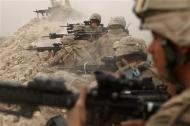Following the Marines Through Helmand
BY Herschel SmithThis is one more in a series at The Captain’s Journal following Marine operations in the Helmand Province, Afghanistan. A brief synopsis of their accomplishments thus far can be found here.
A U.S. Marine fires at a Taliban position near the town of Garmser, a main assembly and staging point for jihadists entering Afghanistan (AP Photo).
U.S. Marines fire on Taliban positions from a sand berm, May 2 (AP Photo).
The Marines continue to take the battle to the Taliban in Garmser.
The spring offensive is well launched – by NATO.
Or, put another way, pre-emptively provoked by the U.S. Marines Expeditionary Force.
If the best defence is a good offence, American troops recently arrived in the southern provinces have wasted no time taking the battle to the Taliban, putting an entirely different complexion on combat tactics in the heartland of the insurgency.
Joining forces with British troops who have responsibility for NATO operations in Helmand province, these battle-hardened Marines – many of them veterans of fierce combat in the Iraqi city of Ramadi two years ago – hurled themselves into the insurgency cauldron last week, with the objective of dislodging Taliban fighters from strongholds north of the border with Pakistan.
Although the British have a base in the town of Garmser, NATO’s most southerly outpost, and have battled strenuously to maintain it against encroachment, the vast surrounding district, much of it inhospitable desert, has been essentially free movement territory for the neo-Taliban.
Garmser is a main assembly and staging point for jihadists as they enter Afghan soil. It is also a key transit route for smuggling in arms and smuggling out opium – the vascular network that pumps blood into the insurgency.
The claims and counterclaims – success versus failure – have been fast and furious. While American authorities claimed on the weekend to have killed nine militants, Taliban spokesperson Qari Yosuf asserted it was the insurgents who had killed nine Americans.
There have been no official reports of U.S. casualties from the fighting. But provincial government sources, along with aid workers in the region, accuse the Marines of conducting aggressive door-to-door searches, rousting civilians from their homes, arresting innocents and forcing upward of 15,000 Afghans to flee into the hot desert for safety.
None of these claims has been confirmed. However, the U.S. propensity for using air strikes and artillery and mortar barrages in support of their ground troops has much of the domestic media here caterwauling about a suddenly “Americanized war” in Afghanistan.
Caterwauling indeed. The British didn’t really hold any terrain inside Garmser proper, and their role in this specific operation was transport (h/t Rogue Gunner). “Although British framework operations are currently focused further north, in the areas of Lashkar Gar, Sangin, Gereshk and Musa Qaleh, the British Task Force has had an important role to play facilitating the move of the MEU down through the province.”
This report on the Marines is somewhat amusing. Whether the “claims and counterclaims” have been fast and furious being quite irrelevant, the success of the Marines has been fast. The Provincial Government is fabricating information about the operation because they don’t know what else to do, but the shock of rapid success will hopefully give way to an understanding of what a change in strategy can accomplish. It is certainly the case that the combat action has been directed and aggressive, with the Marines “unleashing earsplitting barrages of machine gun fire, mortars and artillery” at Taliban positions.
O’Neill, the company commander, says all-day potshots by Taliban fighters are little more than nuisance attacks. The militants use binoculars and have forward observers with cell phones to try to aim better at the Marines, he says.
“This is pure asymmetric harassment,” he says. “They’ll pop out of a position and fire a rocket or mortar.”
But in a bleak British assessment of Garmser a week ago, the UK is said to be losing the battle.
In Garmser, the Scottish infantrymen hope to push the Taliban back and fill the town with people again. The continuing marine operation may help that objective.
But the main British effort is concentrated in northern Helmand, and local governance is weak in Garmser, where most of the town elders and administrators have fled to the provincial capital, Lashkar Gah.
And as the poppy harvest draws to a close, commanders expect a fresh spurt of fighting in the coming weeks. Combined with the stream of Taliban from Pakistan, British officers recognise they are only holding the line.
“I’m under no illusions. We are not stopping the movement north,” said Den-McKay. “We’re just giving them something to talk about.”
Perhaps an alternative picture is emerging for the chaps in the UK – that of aggressive contact with the enemy by enough troops on the ground to accomplish the mission? One can only hope that NATO is watching closely.
Prior:
Marines Mired in Red Tape in Afghanistan







No comments yet.
RSS feed for comments on this post. TrackBack URL
Leave a comment